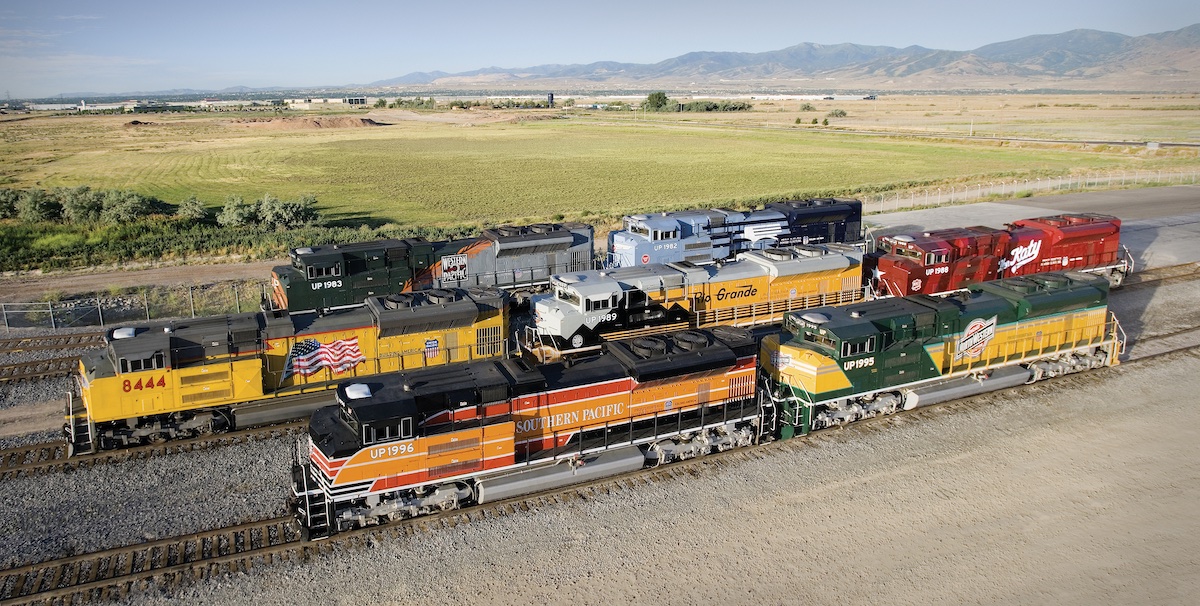
The Union Pacific Railroad is the last major U.S. rail system whose name has never changed, dating from its charter in 1862 to build the nation’s first transcontinental, westward from Omaha, Neb.. Also notable for their longevity are the railroad’s shield-shaped emblem from 1886, and yellow color scheme on its passenger cars and locomotives from the 1930s. But behind the logo and colors is a genealogy of well-known railroads that make up today’s Union Pacific system.
Chicago & North Western
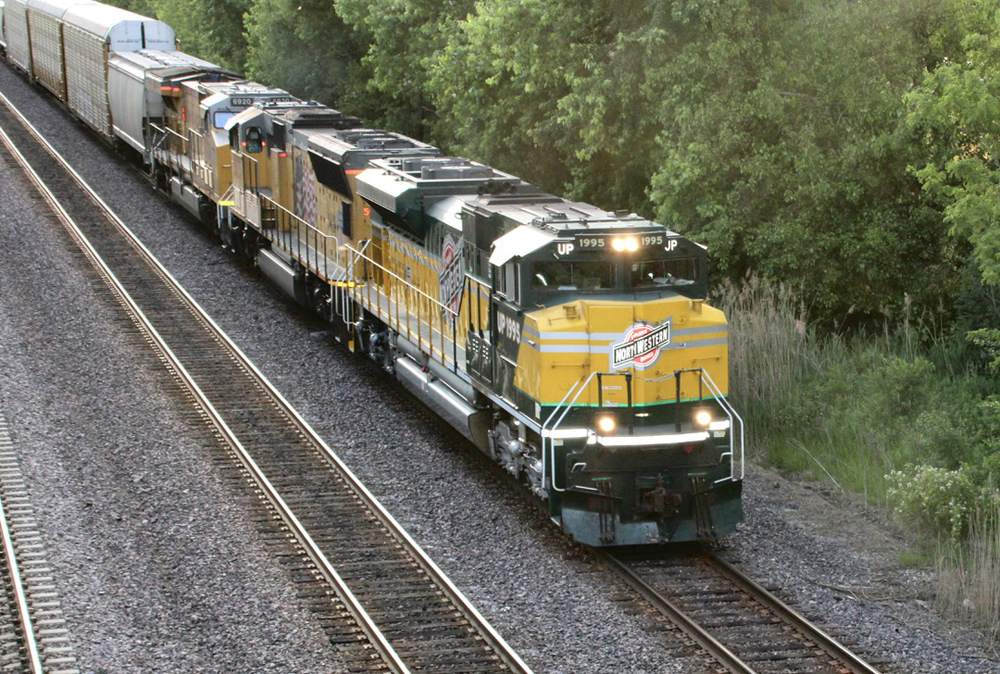
Galena & Chicago Union, Chicago’s first railroad, began construction in 1848. In 1855, the Chicago, St. Paul & Fond du Lac was organized to extend northwestward from near Chicago. The CStP&F was then reorganized in 1859 as the Chicago & North Western, which consolidated with Galena & Chicago Union in 1864. C&NW became employee-owned in 1970. After years of operating affiliation on its main line with the Union Pacific, but no UP control, all C&NW stock was acquired by the UP on April 27, 1995. The Chicago & North Western was merged into the Union Pacific on June 23 of that year.
Chicago, St. Paul, Minneapolis & Omaha Railway
What came to be known as the “Omaha Road” began as the Tomah & Lake St. Croix in Wisconsin on April 1, 1863. After expansions and consolidations, it acquired the name Chicago, St. Paul, Minneapolis & Omaha on May 25, 1880. Controlled by Chicago & North Western after 1882 and operated as a part of C&NW system, it comprised the lines north of Elroy, Wis., and Omaha to Minneapolis-St. Paul and Ashland, Wis. The corporation lasted until 1957, and its official identity was maintained until 1972.
Minneapolis & St. Louis Railroad
Minnesota Western was chartered in 1853. The name was then changed to Minneapolis & St. Louis in 1870. The M&StL purchased Iowa Central in 1912, and in 1956, also purchased the latter-day Minnesota Western — a 1924 creation unrelated to the original. Chicago & North Western purchased the Minneapolis & St. Louis’ railroad assets on Nov. 1, 1960.
Litchfield & Madison Railroad
Litchfield & Madison incorporated on March 1, 1900, to take over an isolated line of Chicago, Peoria & St. Louis between Litchfield and Madison, Ill. The L&M built a connection to the Chicago & North Western at Benld, Ill., in 1926, and served as the East St. Louis entry for both the C&NW and Illinois Central. Merger into the former took place on Jan. 2, 1958.
Chicago Great Western Railroad
Construction began at St. Paul, Minn., southward in September 1884 under A.B. Stickney. Reorganized as the Chicago Great Western in 1892, the system was essentially completed through acquisitions of other lines to Chicago, Omaha, and Kansas City by 1903. It was merged into the Chicago & North Western on July 1, 1968.
Chicago, Rock Island & Pacific Railroad
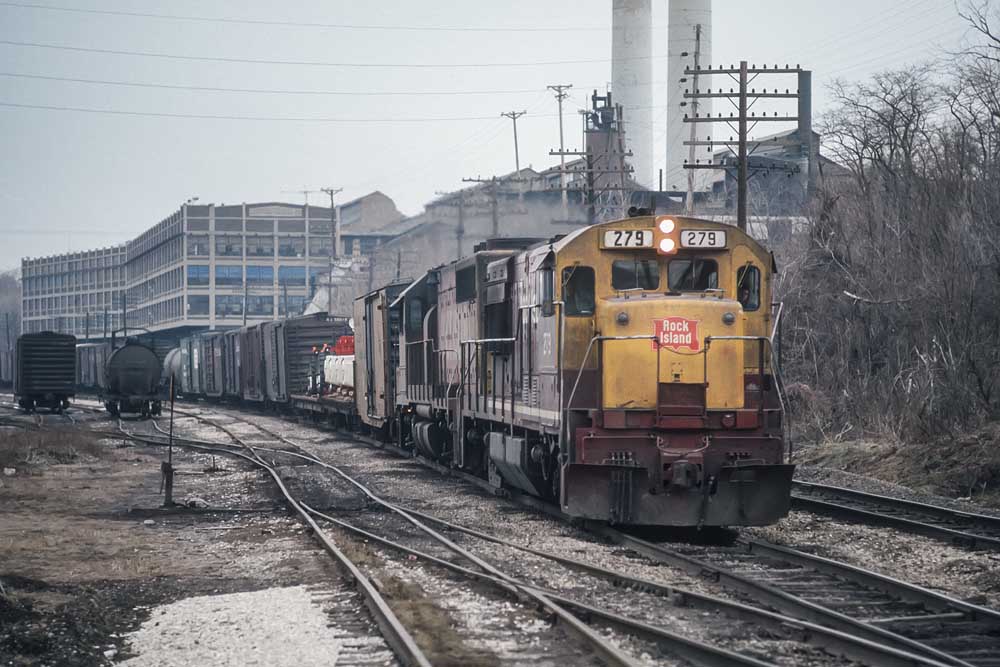
Construction began on Chicago & Rock Island in 1851; renamed Chicago, Rock Island & Pacific in an 1866 reorganization that included the Mississippi & Missouri across Iowa. In 1964, the Union Pacific applied to merge the CRI&P. The Interstate Commerce Commission took a decade to approve it, with a condition that the Southern Pacific purchased the southern half. By then, the Rock Island deteriorated to the point that the UP and SP no longer wanted it. The railroad declared bankruptcy in 1975, and, after a labor strike, ceased operation on March 31, 1980. The vast majority of 7,000 miles wound up being acquired by other carriers: among the largest chunks were 965 miles to SP’s Cotton Belt; 750 miles to the Chicago & North Western; 750 miles to regional Kyle Railroad; 645 miles to a subsidiary of the former Katy (now part of the UP); and 550 miles to the Iowa Railroad, succeeded by today’s regional Iowa Interstate Railroad.
Southern Pacific Lines
The first Southern Pacific ancestor was chartered in Texas in 1851. Meanwhile, the Sacramento Valley opened in California that same year. The Central Pacific Railroad was then incorporated in June 1861, connecting its line to Promontory, Utah, with the Union Pacific to form the first transcontinental railroad on May 10, 1869. CP then acquired SP by 1868, ultimately rebranding into the Southern Pacific Line. Four Texas properties were consolidated in 1934 as the Texas & New Orleans, eventually merging into the SP in 1961. Anschutz Corp., owner of Denver & Rio Grande Western, purchased the Southern Pacific on Aug. 8, 1988, though still retaining the name. Union Pacific acquired the SP on Sept. 11, 1996.
St. Louis Southwestern Railway
St. Louis Southwestern began as the 3-foot-gauge Tyler Tap Railroad, opened in 1877 in eastern Texas. Its successor, St. Louis, Arkansas & Texas, was standard-gauged in 1886. The nickname “Cotton Belt Route” is historic with the emblem, designed by Charles Ware at the railroad’s request, replaced by a cotton bale in 1885. StLA&T was acquired by the new St. Louis Southwestern of Jay Gould in 1891. Southern Pacific acquired SSW control on April 14, 1932, strengthening a relationship established in 1919. Ownership was conveyed to Union Pacific in the Aug. 11, 1996 SP merger, and the SSW was subsequently absorbed.
Northwestern Pacific Railroad
The Northwestern Pacific was incorporated in 1907 by the Southern Pacific and to consolidate several smaller roads north of San Francisco. SP bought the Santa Fe Railway’s interest in 1929, and merged the NWP in October 1992. NWP had no equipment of its own after 1960. Portions north of Willits were then sold to Eureka Southern on Nov. 1, 1984, with the southern portion leased to California Northern on Sept. 26, 1993. This railroad relinquished the lease to a new company, which adopted the Northwestern Pacific name.
Denver & Rio Grande Western Railroad
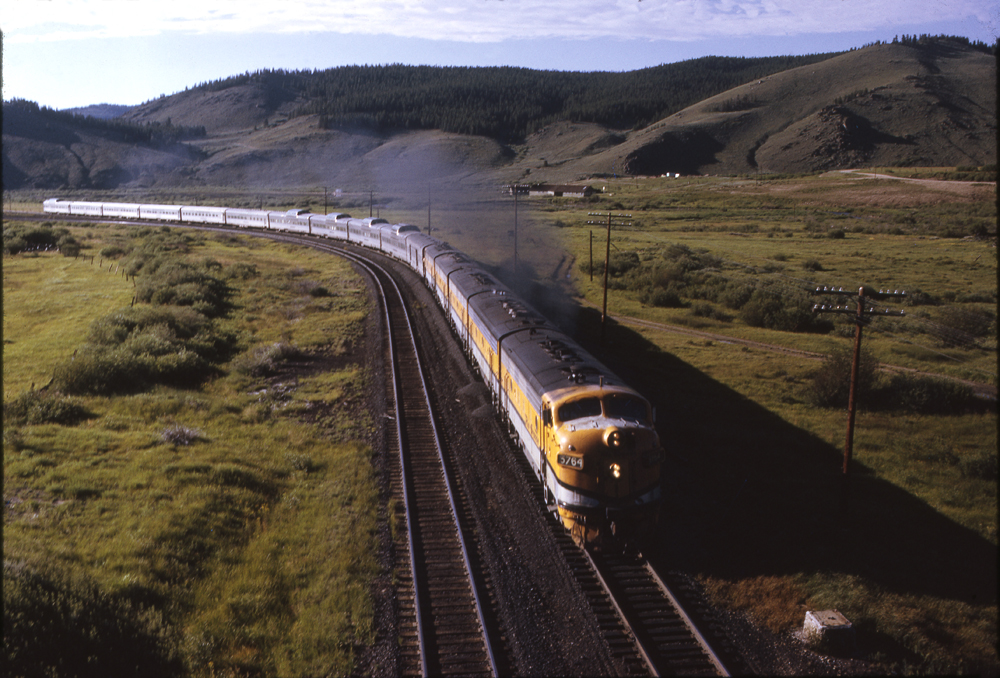
The Denver & Rio Grande incorporated in 1870 to build south from Denver in 3-foot gauge. D&RG leased the affiliated standard-gauge Rio Grande Western, building southeast from Salt Lake City, in 1882. Dotsero Cutoff opened in 1934, forming a connection with the Denver & Salt Lake, which merged into what became the Denver & Rio Grande Western Railroad, on April 11, 1947. The DRGW was acquired by Philip Anschutz in 1984, who on Aug. 9, 1988, then bought the Southern Pacific. The SP name was adopted as the operating label for the combined system.
Denver & Salt Lake Railway
Construction began from Denver west in 1902 as the Denver, Northwestern & Pacific. It was then organized in July 1912 as the Denver & Salt Lake Railway. Moffat Tunnel, named after railroad founder David H. Moffat, opened on Feb. 26, 1928. The Denver & Rio Grande Western acquired D&SL stock, beginning in the 1930s, and merged on April 11, 1947.
Western Pacific Railroad
Taking the same name as the original Sacramento-Oakland part of the Central Pacific, Western Pacific was incorporated in 1903 to extend the Gould empire west of Utah. It was finished in 1909. Both the Santa Fe and Southern Pacific wanted the WP in 1962, but neither got it. Union Pacific ultimately did, merging on Dec. 22, 1981.
Sacramento Northern Railway
Sacramento Northern, a vast San Francisco Bay Area interurban, was formed in 1918 to take over the Northern Electric Co., which dated from 1905. Western Pacific acquired control of the SN in 1921, and gradually absorbed its functions while abandoning most of its lines. Sacramento Northern was still an entity when UP acquired the Western Pacific in 1982.
Spokane International Railway
Spokane International was built from its namesake Washington city, to connect with the Canadian Pacific Railway at the Idaho-British Columbia border in 1906. Union Pacific acquired control of the SI on Oct. 6, 1958.
Missouri Pacific Railroad
Chartered in 1851 as the Pacific Railroad, this railroad opened in 1852, and was renamed Missouri Pacific in 1870. Major early components included the St. Louis & Iron Mountain, chartered in 1851; the International & Great Northern, started in 1873; and the Gulf Coast Lines, a 1913 merger creation. Other entities came under Jay Gould’s control in 1879. Union Pacific absorbed the Missouri Pacific on Dec. 22, 1982, and its operations. However, it didn’t formally merge the MP out of existence until 1997.
Missouri-Kansas-Texas Railroad
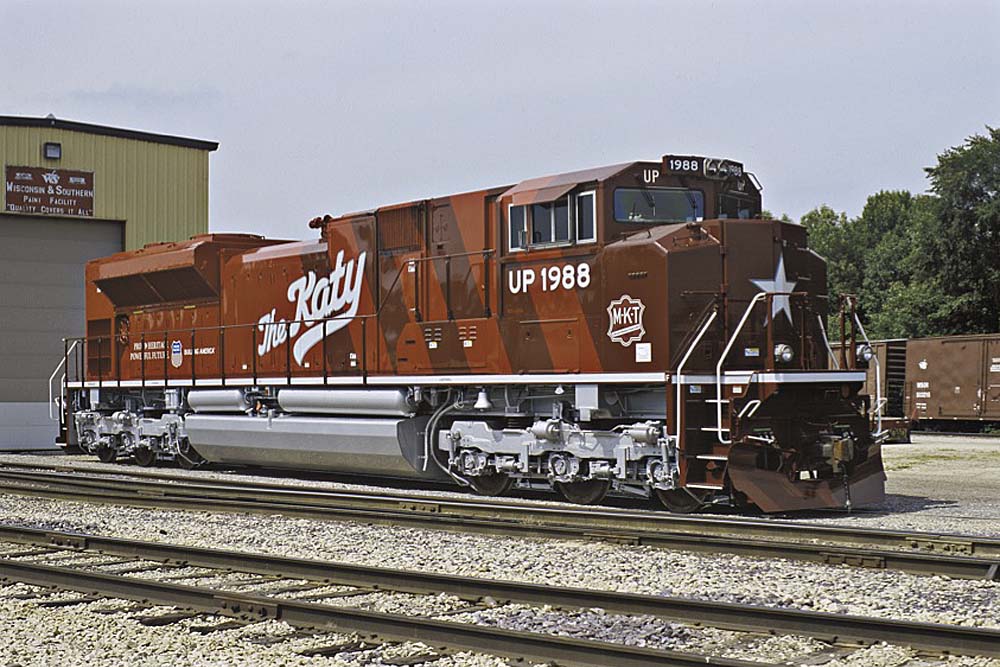
Incorporated in 1865 as Union Pacific Railway Southern Branch (no relation to UP proper). The name changed to the Missouri, Kansas & Texas in 1866. The ampersand was dropped and a hyphen was substituted (Missouri-Kansas-Texas) in a 1923 reorganization. Holding company Katy Industries was then created in 1967. After an off-and-on three-year courtship, the Union Pacific, through subsidiary Missouri Pacific, absorbed the MKT (but not Katy Industries) on Aug. 12, 1988.
Chicago & Eastern Illinois Railroad
The Evansville & Illinois was chartered in 1849 to build north from the Ohio River. The system was completed from Chicago, south in 1872, but was sold at foreclosure in 1877 as the Chicago & Eastern Illinois. Missouri Pacific began merger discussions in 1959, prompting the Louisville & Nashville, and Illinois Central to each petition the ICC for C&EI’s control. It ruled in favor of the MP in 1963, though stipulating that the MP sell L&N the Evansville line, which occurred in 1969. L&N also bought a half-interest in the line from Woodland Jct., Ill., where the ownership splits into Chicago. Missouri Pacific officially merged the Chicago & Eastern Illinois on Oct. 15, 1976.
Texas & Pacific Railway
Chartered by Congress as Texas Pacific in 1871 to build westward from Marshall, Texas, the original name was soon changed to include an ampersand. The Missouri Pacific obtained stock beginning in 1923, and by 1930, owned all T&P preferred stock and the majority of common stock. The MP merged the Texas & Pacific on Oct. 15, 1976.
Midland Valley Railroad; Kansas, Oklahoma & Gulf
The Midland Valley, Kansas, Oklahoma & Gulf, and Oklahoma City-Ada-Atoka railroads were all controlled by Muskogee Company and operated jointly. MV incorporated in 1903, acquiring the KO&G in 1925. The KO&G itself was incorporated in 1918 as a successor to the bankrupt Missouri, Oklahoma & Gulf. OCAA incorporated in 1923 to acquire the Shawnee Division of the Missouri-Kansas-Texas, which was reorganizing. Muskogee Co. authorized the sale of all its rail stocks to the Texas & Pacific in 1962. T&P acquired control in September 1964, but sold the OCAA to Santa Fe. Both the Midland Valley Railroad and Kansas, Oklahoma & Gulf merged into the T&P on April 1, 1967, and April 1, 1970, respectively.
Visit the Trains.com Store for railroad merger family tree posters.















